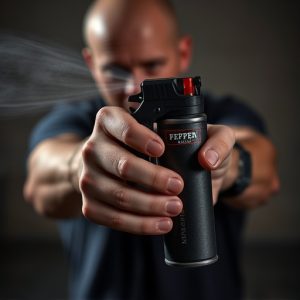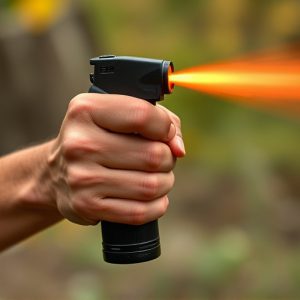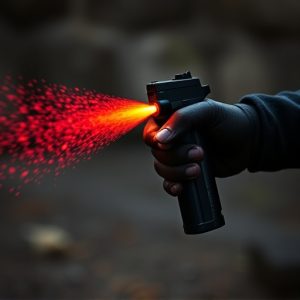Safe Use of Pepper Spray: Understanding Irritants, Legalities, and Alternatives
When to Use Pepper Spray Safely: Pepper spray, an effective personal protection tool, disrupts cell…….
When to Use Pepper Spray Safely: Pepper spray, an effective personal protection tool, disrupts cell functions through capsaicin, causing temporary incapacitation. Its safe use requires understanding when to deploy it (as a last resort against imminent threats) and minimizing risk to bystanders. Legalities vary by region, training is crucial for proper handling, and knowledge of its limitations (20-60 minute effectiveness) is essential. Other personal protection devices like alarms and stun guns offer alternative solutions based on environment and threat level.
“Personal protection devices like pepper spray have become essential tools for self-defense, offering a non-lethal way to deter potential threats. This article delves into the science and effectiveness of chemical irritants, specifically focusing on pepper spray. We explore its legal implications and provide insights on safe handling practices to prevent misuse. Additionally, we investigate alternatives, weighing their efficacy in different scenarios. Understanding when and how to use pepper spray safely is crucial for individuals seeking effective personal protection.”
- Understanding Chemical Irritants: The Science Behind Pepper Spray
- When is Pepper Spray Legal and Effective for Personal Protection?
- Safe Handling and Application Techniques to Avoid Misuse
- Exploring Alternatives: Other Personal Protection Devices and Their Efficacy
Understanding Chemical Irritants: The Science Behind Pepper Spray
Chemical irritants, like pepper spray, have become essential components in personal protection devices for individuals across various sectors, from law enforcement to self-defense enthusiasts. Understanding how these substances work is crucial when it comes to safe and effective use. Pepper spray, a common chemical irritant, contains capsaicin, the active ingredient found in chili peppers. When deployed, it creates an intense irritation in the eyes, nose, and respiratory system, temporarily disabling an attacker.
The science behind pepper spray involves its ability to disrupt normal cell function by binding to specific receptors in the body’s pain pathways. This reaction leads to the symptoms associated with exposure, primarily tearing, sneezing, coughing, and difficulty breathing. Knowing when and how to use pepper spray safely is paramount. It should only be employed as a last resort when facing an imminent threat, ensuring minimal risk to bystanders and the user themselves. Proper training in its application and understanding the legal implications of its use are vital for those carrying such devices.
When is Pepper Spray Legal and Effective for Personal Protection?
Pepper spray, a chemical irritant designed for personal protection, is only legal and effective in specific circumstances. Its use varies greatly depending on regional laws and regulations, which dictate when and where it can be carried and employed. In many jurisdictions, pepper spray is permitted for individuals who feel threatened or are at risk of physical harm, especially in situations where other non-lethal self-defense methods may not be readily available or effective.
When used safely and responsibly, pepper spray can deter potential attackers, providing a crucial window of opportunity for the user to escape. However, it’s essential to understand that its effects are temporary, lasting typically 20-60 minutes, after which the individual may still require medical attention due to residual irritation. Proper training in its use is paramount, as incorrect application can result in accidental injury or even exacerbate the situation.
Safe Handling and Application Techniques to Avoid Misuse
When to Use Pepper Spray Safely, involves understanding proper handling and application techniques to avoid misuse. It’s crucial to store pepper spray in a secure, controlled environment, away from reach of children or unauthorized individuals. Always keep it in its original packaging with all labels intact for easy identification. Before using, ensure the spray is charged and the safety mechanism is engaged.
During application, maintain a safe distance, typically 2-3 feet, to avoid direct contact. Aim for the attacker’s face, eyes, and nose, as these areas are most sensitive. Spraying in quick, short bursts is effective; a single, prolonged blast can cause windburn. After use, wash your hands thoroughly and dispose of the spray according to local regulations. Proper training and practice drills can help individuals develop confident, accurate application techniques for self-defense purposes.
Exploring Alternatives: Other Personal Protection Devices and Their Efficacy
In addition to chemical irritants like pepper spray, there are several other personal protection devices available that offer different levels of safety and effectiveness. While each has its advantages, understanding when and how to use them safely is paramount. For instance, personal alarm devices can be highly effective in deterring potential attackers, drawing attention to the user’s distress with loud sirens or flashing lights. However, their success relies on the presence of bystanders who can hear and respond to the alarm.
Stun guns, another alternative, deliver an electric shock that temporarily disables an assailant. Yet, their range is limited, and proper handling is crucial to avoid causing harm to bystanders or oneself. When considering these options, it’s essential to assess the situation’s dynamics: environment, potential threat level, and available assistance. Knowing when and how to deploy these devices safely can significantly enhance personal security, especially in situations where pepper spray might not be the most suitable or effective solution.
Pepper spray, as a chemical irritant for personal protection, is a powerful tool when used responsibly. Understanding its science, legal considerations, and safe handling techniques is crucial for effective self-defense. While it may be tempting to explore alternatives, pepper spray remains a reliable option in many situations. By following the guidelines outlined in this article, individuals can make informed decisions about when to use pepper spray safely, ensuring their personal protection without causing unnecessary harm.


